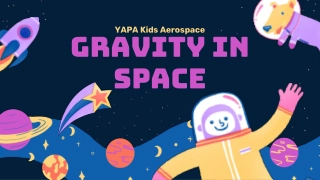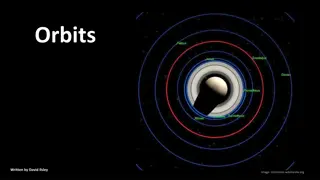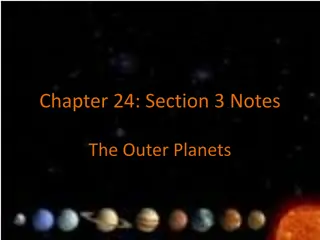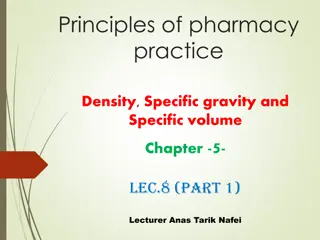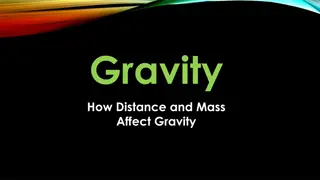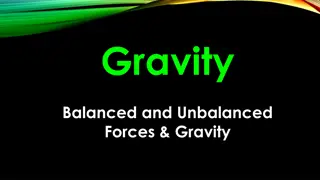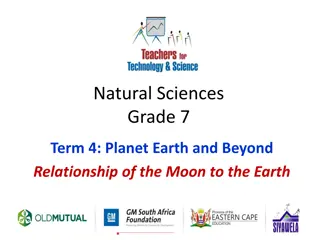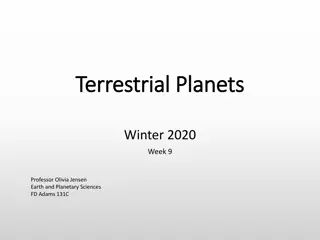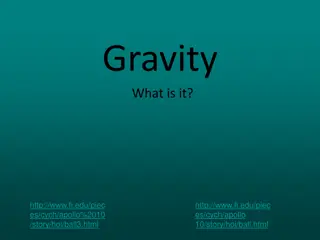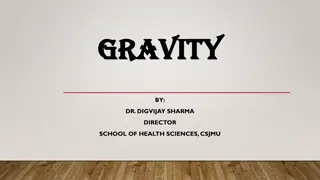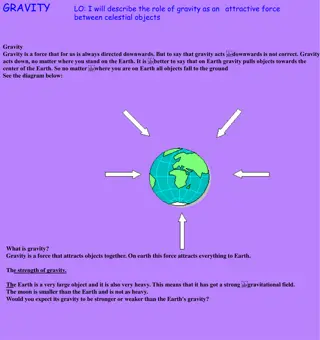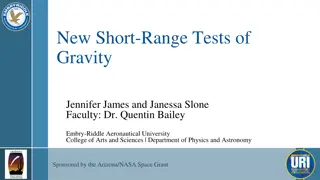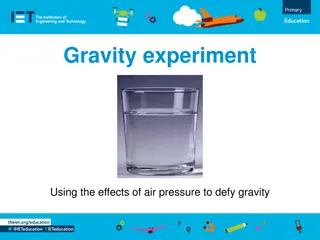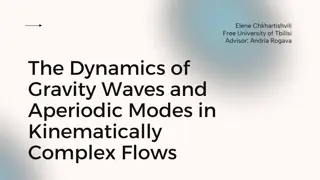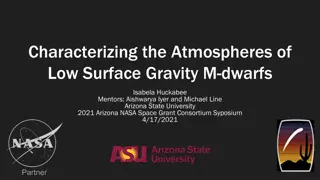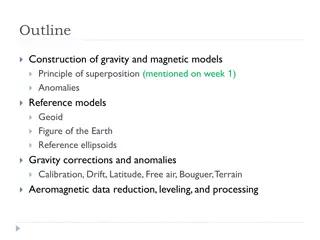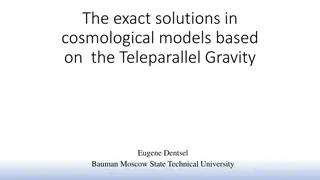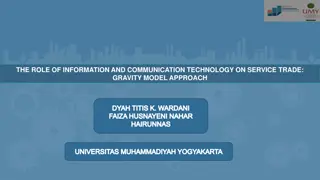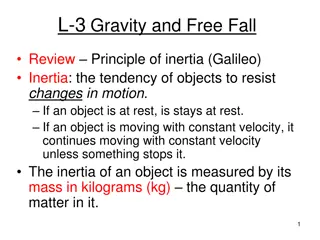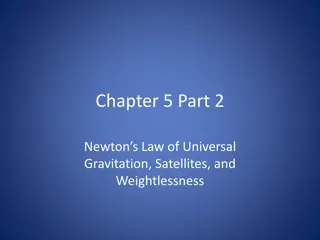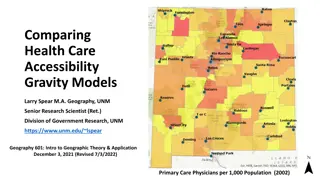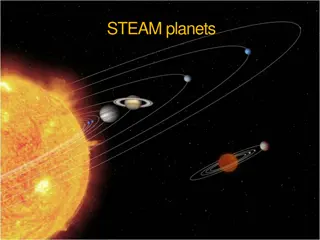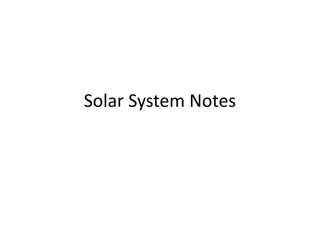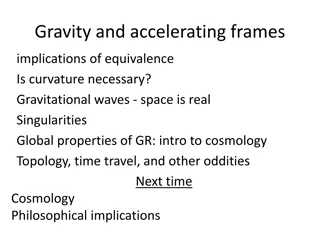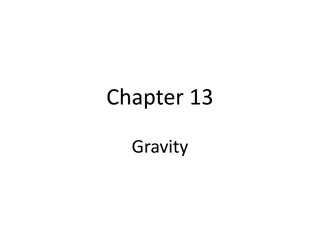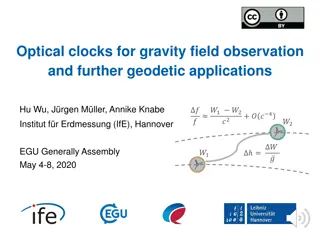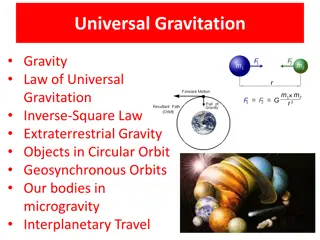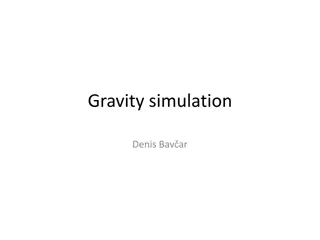Gravity in Space
Discuss the force of gravity, its impact on Earth and space, and how aerospace engineers utilize it. Learn why gravity is crucial in aerospace exploration and its effects on objects in space. Discover how gravity varies in different environments and its significance in space exploration.
1 views • 13 slides
Understanding Orbits and Gravity in Space
Explore the concept of orbits and gravity in space by following the trajectory of a satellite above Earth. Learn how gravity keeps the satellite in a perpetual state of orbit, moving at a constant speed parallel to the ground due to the Earth's round shape. Discover how varying speeds affect orbit s
0 views • 34 slides
Exploring the Outer Planets: Jupiter and Saturn
Discover fascinating details about the outer planets Jupiter and Saturn, from Jupiter's gaseous composition and iconic Great Red Spot to Saturn's impressive rings and unique characteristics like being the "Ringed Planet." Explore the moons of Jupiter, including the Galilean Moons, and learn about Sa
0 views • 18 slides
Understanding Density and Specific Gravity in Pharmacy Practice
Density and specific gravity are important concepts in pharmacy practice for measuring mass and volume relationships of substances. Density is the mass per unit volume of a substance, usually expressed in grams per cubic centimeter, while specific gravity is the ratio of the weight of a substance to
0 views • 21 slides
Understanding Gravity: The Impact of Distance and Mass
Objects with mass exert gravitational force, influencing each other based on mass and distance. Gravity, a fundamental force, keeps objects like Earth and the moon in orbit and affects how objects fall towards each other. The relationship between distance and gravity is crucial, affecting the streng
0 views • 12 slides
Understanding Gravity and Balanced/Unbalanced Forces in Physics
Explore the fundamental concepts of gravity and balanced/unbalanced forces in physics. Gravity is the force that pulls objects toward each other, acting universally. Balanced forces maintain object stability, while unbalanced forces can cause motion changes based on direction, strength, and mass. Di
0 views • 9 slides
Understanding Gravity and Its Role in the Solar System
Explore the relationship of the Moon to Earth and the concept of gravity in the context of natural sciences for Grade 7 students. Learn about the center of gravity, the force of gravity, and the role gravity plays in the movement of celestial bodies within the solar system.
0 views • 6 slides
Understanding Orbital Dynamics: Kepler's Laws and Newtonian Gravity
Delve into the fascinating world of orbital dynamics as we explore Kepler's Laws and Newtonian Gravity. From understanding the elliptical orbits of planets around the Sun to uncovering the role of gravity in shaping celestial motion, this journey will illuminate the fundamental principles governing
0 views • 18 slides
Understanding Gravity and Forces in Physics
Gravity is a natural force that pulls objects towards the Earth's center, affecting how they fall based on mass. This presentation explores what gravity is, the impact of forces on objects, and how mass influences the effect of gravity. It demonstrates how objects like a bouncy ball and a marble fal
0 views • 8 slides
Insights into Dark Energy Detection and Gravity Tests
This collaboration delves into direct detection of dark energy, evidencing acceleration in expansion and delving into the evolution of background cosmology. Gravity tests, including solar system trials, are discussed, along with models like f(R) gravity and chameleon screening in the context of scal
0 views • 20 slides
Understanding Acceleration and Gravity in Physics
Explore the concepts of acceleration and gravity in physics through engaging images and key points. Learn about mass, weight, Newton's Law of Gravitational Attraction, and the acceleration due to Earth's gravity. Discover how all objects fall at the same rate regardless of mass and what factors can
3 views • 31 slides
Understanding Gravity and Center of Gravity in Physics
Gravity is the force of attraction between masses, such as Earth and objects. It gives weight to objects and has a magnitude of 32ft/s2 on Earth. The Center of Gravity (COG) is a hypothetical point where all mass appears concentrated. It plays a crucial role in determining how objects balance and mo
0 views • 13 slides
Understanding Gravity: A Fundamental Force in the Universe
Gravity is a ubiquitous force that attracts celestial objects towards each other, playing a crucial role in keeping planets in their orbits around the Sun and moons around their parent planets. This force, described by Newton's laws, is responsible for phenomena like tides and maintaining the motion
0 views • 7 slides
Understanding Acceleration, Gravity, and Forces in Physics
Explore the concepts of acceleration, gravity, and forces in physics. Learn how acceleration is measured, understand the force of gravity and its impact on falling objects, and discover the relationship between force and mass. Dive into practical applications and the role of friction in motion.
4 views • 8 slides
Understanding Gravity: The Force that Shapes Our Universe
Sir Isaac Newton's discovery of gravity revolutionized our understanding of the universe, explaining the force that keeps us grounded on Earth and governs the motion of celestial bodies. Gravity, as described by the Law of Universal Gravitation, is an attractive force that acts between all objects i
1 views • 19 slides
Short-Range Tests of Gravity: Theoretical Physics Project Overview
This project focuses on calculating modifications to the Newtonian gravitational force through experimental short-range tests of gravity. Utilizing the Standard-Model Extension (SME) test framework to search for potential violations of General Relativity and Newtonian Gravity. Key objectives include
1 views • 7 slides
Gravity Experiment Using Air Pressure to Defy Gravity
Explore a fascinating gravity experiment utilizing the effects of air pressure to challenge gravity. Follow simple steps with visual aids to witness how a piece of card sticks to a glass filled with water when inverted. Understand the science behind this intriguing phenomenon and engage in hands-on
1 views • 5 slides
Exploring Gravity Waves and Aperiodic Modes in Kinematically Complex Flows
Delve into the dynamics of gravity waves and aperiodic modes in kinematically complex flows in this detailed study by Elene Chkhartishvili from Free University of Tbilisi. The research covers topics like internal gravity waves, main formalism, linearization of the velocity field, main equations, and
0 views • 16 slides
Characterizing the Atmospheres of Low Surface Gravity M-dwarfs
This study focuses on characterizing the atmospheres of low surface gravity M-dwarfs, which are promising hosts for exoplanets. The research delves into why low gravity M-dwarfs appear brighter in the infrared than typical M-dwarfs, presenting an improved base model with added opacities. The finding
0 views • 8 slides
Understanding Density, Specific Gravity, and Specific Volume in Pharmacy Practice
Explore the principles of density, specific gravity, and specific volume in pharmacy practice. Learn how to define and calculate these properties, apply specific gravity conversions, and understand the differences between density and specific gravity. Discover practical examples and calculations to
0 views • 24 slides
Understanding Gravity and Magnetic Models in Geophysics
Construction of gravity and magnetic models involves principles of superposition to isolate anomalies, reference ellipsoids, geoid, and various corrections like drift, latitude, free air, Bouguer, and terrain corrections. Gravity anomalies are determined by subtracting multiple factors from observed
0 views • 15 slides
Observational Constraints on Viable f(R) Gravity Models Analysis
Investigating f(R) gravity models by extending the Einstein-Hilbert action with an arbitrary function f(R). Conditions for viable models include positive gravitational constants, stable cosmological perturbations, asymptotic behavior towards the ΛCDM model, stability of late-time de Sitter point, a
1 views • 12 slides
Exact Solutions in Cosmological Models Based on Teleparallel Gravity
Precision in cosmological models based on teleparallel gravity is explored, including fundamental theories, modifications, and applications in the context of General Relativity. The construction principles of GR modifications, characteristic tensors, relation between different metric-affine geometri
0 views • 17 slides
The Role of ICT in Service Trade: Gravity Model Approach
Information and Communication Technology (ICT) plays a crucial role in international service trade, with the application of the gravity model theory to analyze the flow of trade. This study explores how technology, particularly ICT, influences service trade within the ASEAN region. It delves into th
0 views • 21 slides
Understanding Gravity and Inertia: Key Concepts in Motion
Exploring the principles of inertia and gravity, this content delves into how objects resist changes in motion and the force that attracts objects towards each other. From Newton's Law of Gravity to the dynamics of free fall and weight, learn how these fundamental concepts shape our understanding of
0 views • 21 slides
Understanding Newton's Law of Universal Gravitation
Newton's Law of Universal Gravitation explores the concept of gravity, how it affects different bodies in space, and the relationship between mass, distance, and gravitational force. Newton's pioneering work in this area laid the foundation for understanding the forces that govern the movement of pl
0 views • 22 slides
Comparing Health Care Accessibility Gravity Models in Geographic Theory
This study by Larry Spear, a Senior Research Scientist at UNM, delves into the concept of spatial interaction and the application of gravity models in analyzing health care accessibility. It discusses the development and comparison of one-step and two-step gravity models, addressing the issue of pat
3 views • 12 slides
Gravity Waves as a Mechanism of Coupling Oceanic and Atmospheric Acoustic Waveguides to Seismic Sources
Direct excitation of acoustic normal modes in horizontally stratified oceanic waveguides is negligible for shallow earthquakes due to velocity disparities. This study evaluates the contribution of scattering by hydrodynamic waves in generating abyssal T-waves. The research explores the role of scatt
1 views • 6 slides
Understanding Vertical Motion and Gravity in Kinematics
Explore the principles of vertical motion and gravity in kinematics through scenarios involving throwing objects, free-fall motion, and calculating heights. Learn how to model vertical motion with acceleration due to gravity, find maximum heights of thrown objects, solve extended problems, and under
2 views • 12 slides
Understanding Sedimentation in Water Treatment Processes
Sedimentation is a crucial unit operation in water treatment involving the settling of solids in liquids to form sediments. Gravity plays a key role in this process, drawing particles towards the bottom of the vessel. Differentiating between settling and sedimentation is important, with settling bei
2 views • 14 slides
Fun with Weight: Exploring Gravity Across Different Planets
Explore the concept of weight and gravity by comparing how objects weigh differently on Earth, Mars, the Moon, Jupiter, and Saturn. Learn about fractions to estimate weight changes and discover how gravity influences weight variations on different planets and celestial bodies. Get ready for an engag
0 views • 6 slides
Understanding the Role of Center of Gravity and Levers in Object Balance
Explore concepts of center of gravity, stability, and equilibrium in objects through investigations on balancing techniques and finding the center of gravity of irregular shapes. Discover how levers and turning forces affect object balance and design for stability.
0 views • 33 slides
Explore Our Solar System: Planets, Moons, and More
Delve into the wonders of our solar system, from Mercury, the closest planet to the Sun, to Jupiter, the largest planet with its multitude of moons. Learn fascinating facts about each planet's unique characteristics, including their distances from the Sun, lengths of days and years, and intriguing f
0 views • 15 slides
Exploring the Solar System: Planets, Orbits, and More
Dive into the fascinating world of the solar system with this chapter on Astronomy. Learn about planets, moons, asteroids, comets, and more as they orbit the Sun. Understand the forces of gravity and inertia that keep celestial bodies in motion and explore ancient ideas about planetary motion. Disco
0 views • 26 slides
Exploring the Implications of Gravity and Accelerating Frames in General Relativity
Delve into the fascinating world of General Relativity as we discuss the equivalence principle, gravitational waves, properties of spacetime, and the effects of curvature in the presence of gravity. Discover how Einstein's revolutionary theories have reshaped our understanding of the universe, leadi
0 views • 15 slides
Understanding Gravity and its Applications
Explore the fascinating world of gravity through topics like the law of gravity, gravitational force, superposition, and more. Dive into concepts such as net gravitational force, acceleration due to gravity, and gravitational forces in various scenarios. Understand how gravity influences objects in
0 views • 68 slides
Understanding Fluids: Density, Specific Gravity, and Pressure in Liquids and Gases
Fluids such as liquids and gases possess properties like density, specific gravity, and pressure that play a crucial role in their behavior. Density measures the heaviness of a material, while specific gravity compares the mass of a material to that of water. Pressure affects the density of fluids,
0 views • 55 slides
Optical Clocks for Gravity Field Observation and Geodetic Applications
Optical clocks play a crucial role in observing gravity fields and have various geodetic applications. From comparing space-to-ground and space-to-space clocks to detecting mass loss in Greenland, these clocks offer high-frequency sampling data for precise measurements. They also aid in unifying hei
0 views • 10 slides
Understanding Universal Gravitation: The Force of Gravity Explained
Gravity is a fundamental force present in all matter, governed by the Law of Universal Gravitation. This law explains how objects exert forces on each other based on their masses and distances. Gravitational forces influence celestial bodies, orbits, and human experiences like microgravity. Learn ab
0 views • 20 slides
Understanding 2D Gravity Simulation in C++ Code
Explore the concept of simulating gravity in a 2D environment using C++ code. Discover how large objects attract small objects and the mathematical equations involved in calculating gravitational effects. Dive into the important segments of C code and kernel functions to grasp the intricacies of gra
0 views • 6 slides
